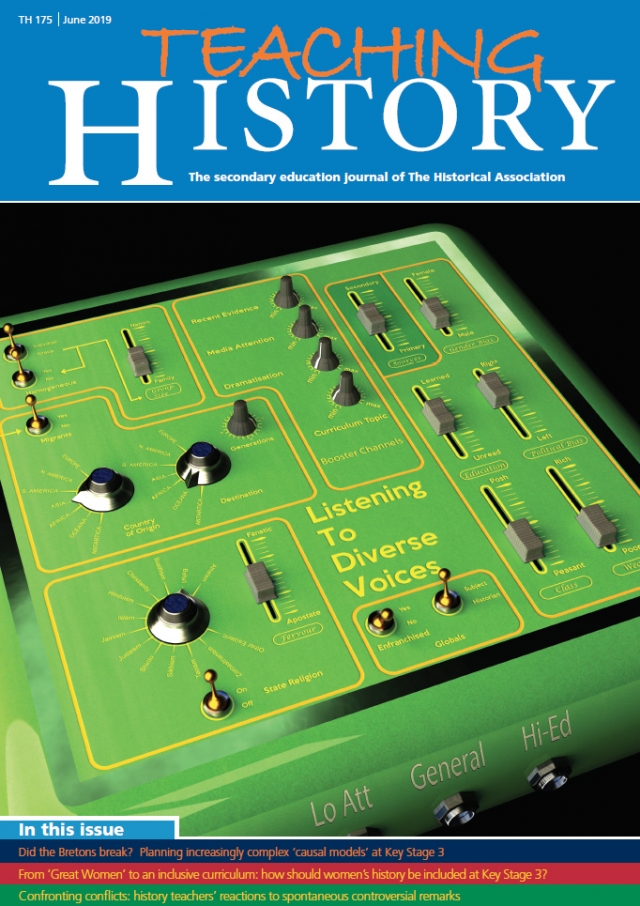Teaching History 175: Out now

Listening to Diverse Voices
The effort to discern hidden voices is intrinsic to the integrity of historical practice. The professional historian poring over primary sources strives to establish who can be heard in any text or artefact, which voices are being inadvertently favoured or what light further voices might shed on the question in hand. More fundamentally, in framing a question in the first place, historians make judgements about the significance of voices whose testimonies or relics they will bring to bear on their enquiry.
The school history teacher’s task is somewhat different. First, on a macro-level, teachers have always agonised over and debated what content to teach. That challenge, rather different from that of the professional historian, is informed by the near-impossible task of ensuring that across the entire diet of school history, the diversity of human beings’ lived experience is attended to. Meanwhile, on a micro-level, we see a more direct echo of an ethic driving the historian’s practice. While the classroom is not the place where historical problems are researched in great depth and published for scholars and the public, nonetheless, when history teachers are teaching the process of argument or evidential thinking, then, at our dogged and passionate best, we simulate and model these practices for pupils. There we capture something of the historian’s tenacity. What are the limitations of what we can infer from this source? Who is missing in this kind of response to the question? What kind of question is this? What’s the agenda of this narrative? What doesn’t this narrative tell us? Why?
This edition is certainly a continuation of our decades-old teacher tradition of debating what to teach. But it is actually a good deal more than that, for in the history education community it breaks new ground. What our authors do is to relate the question of diverse voices to the deep structures of historical argument and historical practice that we conventionally teach.
Working within history teachers’ traditions of exploring the curricular role of narrative, Goudie and Foster noticed that pupils were failing to concern themselves with narrative structure, especially the weighting and sequencing of material, and failing to determine the type of argument that these narrative decisions enshrine. Building on recent work by practising teachers such as Carroll and Rodker, and on close reading of historians’ work, Goudie and Foster built a practical approach for teaching Year 9 pupils what narrative does and the historical responsibility that goes with shaping it.
Like Foster and Goudie, Matt Stanford examines the relationship between narrative and argument. Considering the effects that particular narratives of the Norman invasion have on pupils’ subsequent arguments, he shows how the much-loved versions of familiar stories can directly influence possibilities for pupils’ causal reasoning. Stanford heightens our awareness of the evidential roots of our stories, and the roles and experiences that the sources silence or foreground. What our stories say about Bretons or Normans does matter.
Meanwhile, Diana Laffin, in her Cunning Plan, uses the England’s Immigrants database to unearth sources which change her pupils’ view of an entire century. Asking, ‘How far did trade and migration change England in the sixteenth century? Laffin’s pupils realised that investigating England’s textile trade yields patterns of socio-economic and cultural change that are rarely brought into focus through a story that focuses more on politics and religion. McDonnell also goes back to the source record and steeps his GCSE pupils in the teeming complexity of nineteenth-century Whitechapel by exposing them to sources far longer than those pupils normally study in school. The impulse to do this arose from frustration with the typical confusions in pupils’ responses to source-based examination questions. McDonnell concluded that only by getting closer to rich contextual depth that longer sources convey, and simulating the iterative, critical reading process of historians, would his pupils start to see what all this work with sources is for – an insight likely to be denied if all that pupils experience is tiny gobbets and formulaic questions.
This theme of the necessarily dialogic quality of historical work with sources is one taken up by Michael Bird and Thomas Wilson. They focus their attention on the voices of pupils, in dialogue with their teacher and with each other, as they draw inferences from differing sources about the Norman legacy in Chester. By carefully examining dialogue stimulated by these sources, Bird and Wilson demonstrate not only the role that prior knowledge plays in such interaction, but also the role that the dialogue itself plays in shaping the knowledge that emerges.
Such dialogue in the history classroom is rarely straightforward to manage, requiring both deep understanding of history’s forms and purposes, and great skill in enabling diverse pupils to enter its conversations. This is never harder than when history intersects with disturbing or controversial current events. What is the history teacher to do when profound differences of perspective burst into a classroom? A group of researchers and teacher educators in Belgium and the Netherlands, Wansink, Patist, Zuiker, Savenije and Janssenswillen, confront the toughest of challenges: when pupils’ spontaneous remarks are highly pertinent to the subject matter in hand but potentially inflammatory in their effects on the rest of the class. Wansink et al offer a model to support history teachers in analysing, understanding and responding to such situations.
In curricular terms, perhaps this edition’s the most far-reaching challenge to listen afresh to diversity comes from Susanna Boyd who classifies typical approaches to women’s history and finds almost all of them wanting. Subjecting her own planning to her own rigorous test, she offers practical illustration of how surfacing the lived experience and roles of women profoundly disrupts some narrative parameters we may have failed to question.

